2008 MERCEDES-BENZ SL ROADSTER run flat
[x] Cancel search: run flatPage 10 of 317
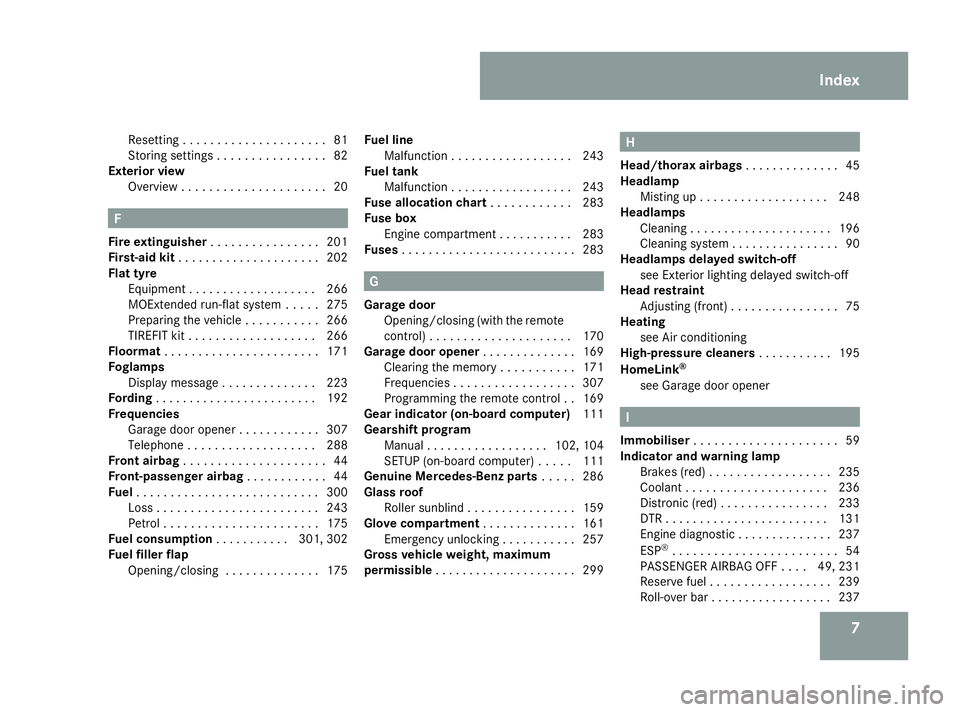
7
Resettin
g.................... .81
Storing settings ................ 82
Exterior view
Overview ..................... 20F
Fire extinguisher ................ 201
First-aid kit ..................... 202
Flat tyre Equipment ................... 266
MOExtended run-fla tsystem ..... 275
Preparing the vehicle ...........266
TIREFIT kit ................... 266
Floormat ....................... 171
Foglamps Display message .............. 223
Fording ........................ 192
Frequencies Garage door opene r............ 307
Telephone ................... 288
Fron tairbag ..................... 44
Front-passenger ai rbag ............ 44
Fuel ........................... 300
Loss ........................ 243
Petrol ....................... 175
Fue lcon sumption ........... 301, 302
Fue lfiller flap
Opening/closing .............. 175Fue
lline
Malfunction .................. 243
Fue ltank
Malfunction .................. 243
Fuse allocatio nchart ............ 283
Fuse box Engine compartment ...........283
Fuses .......................... 283 G
Garage door Opening/closing (with the remote
control) ..................... 170
Garage door opener ..............169
Clearing the memory ...........171
Frequencies .................. 307
Programming the remote control ..169
Gear indicator (on-board computer) 111
Gearshift program Manual .................. 102, 104
SETUP (on-board computer) .....111
Genuine Mercedes-Benz parts .....286
Glass roof Roller sunblind ................ 159
Glove compartment ..............161
Emergency unlocking ...........257
Gross vehiclew eight, maximum
permissible ..................... 299 H
Head/thorax airbags ..............45
Headlamp Misting up ................... 248
Headlamps
Cleaning ..................... 196
Cleaning system ................ 90
Headlamps delaye dswitch-off
see Exterior lighting delayed switch-off
Head restraint
Adjusting (front) ................ 75
Heating
see Air conditioning
High-pressure cleaners ...........195
HomeLink ®
see Garage door opener I
Immobiliser ..................... 59
Indicator an dwarning lamp
Brake s(red ).................. 235
Coolant ..................... 236
Distronic (red )................ 233
DTR ........................ 131
Engine diagnostic .............. 237
ESP ®
........................ 54
PASSENGER AIRB AGOFF .... 49, 231
Reserve fuel .................. 239
Roll-over bar .................. 237 Index
230_AKB; 5; 4, en-GB
bjanott,
Version: 2.9.6 2008-04-08T15:09:54+02:00-Seite 7 Dateiname: 6515_3089_02_buchblock.pdf; preflight
Page 12 of 317
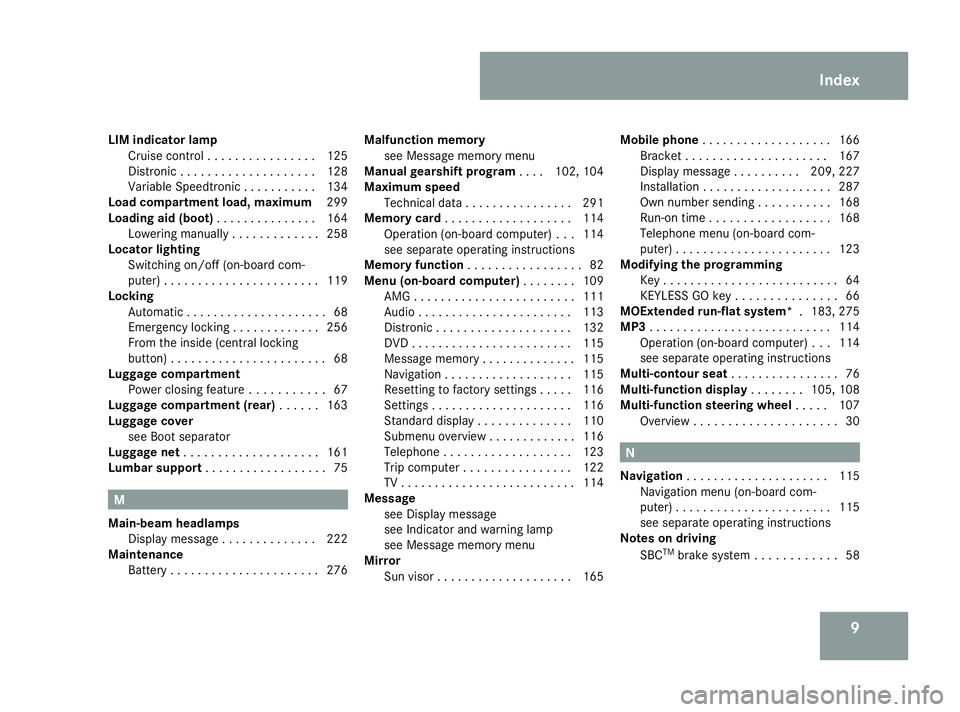
9
LIM indicator lamp
Cruise control ................ 125
Distronic .................... 128
Variabl eSpeedtronic ........... 134
Load compartment load, maximum 299
Loading aid (boot) ............... 164
Lowering manually .............258
Locator lighting
Switching on/off (on-board com-
puter) ....................... 119
Locking
Automatic ..................... 68
Emergency locking .............256
From the insid e(central locking
button) ....................... 68
Luggage compartment
Powe rclosing feature ........... 67
Luggage compartmen t(rear) ...... 163
Luggage cover see Boot separator
Luggage net .................... 161
Lumbar support .................. 75M
Main-beam headlamps Display message .............. 222
Maintenance
Battery ...................... 276Malfunction memory
see Message memory menu
Manual gearshift program ....102, 104
Maximum speed Technical data ................ 291
Memory card ................... 114
Operation (on-board computer) ...114
see separate operating instructions
Memory function ................. 82
Menu (on-board computer) ........109
AMG ........................ 111
Audi o....................... 113
Distronic .................... 132
DVD ........................ 115
Message memory .............. 115
Navigation ................... 115
Resetting to factory settings .....116
Settings ..................... 116
Standard displa y.............. 110
Submenu overview .............116
Telephone ................... 123
Trip computer ................ 122
TV .......................... 114
Message
see Display message
see Indicator and warning lamp
see Message memory menu
Mirror
Sun viso r.................... 165Mobile phone
................... 166
Bracket ..................... 167
Display message ..........209, 227
Installatio n................... 287
Own numbe rsending ........... 168
Run-on time .................. 168
Telephone menu (on-board com-
puter) ....................... 123
Modifying the programming
Key .......................... 64
KEYLESS GO key ............... 66
MOExtended run-flat system* .183, 275
MP3 ........................... 114
Operation (on-board computer) ...114
see separate operating instructions
Multi-contour seat ................ 76
Multi-function display ........105, 108
Multi-functio nsteering wheel .....107
Overview ..................... 30 N
Navigation ..................... 115
Navigation menu (on-board com-
puter) ....................... 115
see separate operating instructions
Notes on driving
SBC TM
brake system ............ 58 Index
230_AKB; 5; 4, en-GB
bjanott,
Version: 2.9.6 2008-04-08T15:09:54+02:00-Seite 9 Dateiname: 6515_3089_02_buchblock.pdf; preflight
Page 44 of 317
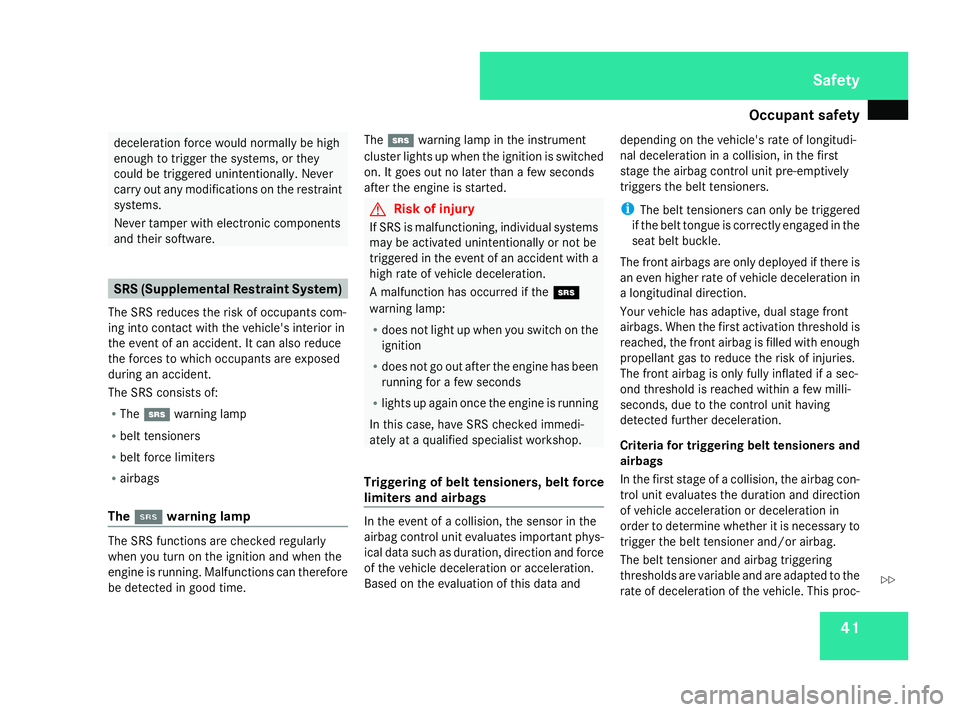
Occupant safety
41deceleration forc
ewould normally be high
enough to trigger the systems ,orthey
could be triggered unintentionally. Never
carry out any modifications on the restraint
systems.
Never tamper with electronic components
and their software. SRS (Supplementa
lRestraint System)
The SRS reduces the risk of occupants com-
ing int ocontact with the vehicle's interior in
the event of an accident. It can also reduce
the forces to which occupants are exposed
during an accident.
The SRS consists of:
R The 1 warning lamp
R belt tensioners
R belt forc elimiters
R airbags
The 1 1 warning lamp The SRS function
sare checked regularly
when you turn on the ignition and when the
engin eisrunning. Malfunctions can therefore
be detected in good time. The
1 warning lamp in the instrument
cluster lights up when the ignition is switched
on. It goes out no later than afew seconds
after the engin eisstarted. G
Risk of injury
If SRS is malfunctioning, individual systems
may be activated unintentionally or not be
triggered in the event of an acciden twith a
high rate of vehicle deceleration.
Am alfunction has occurred if the 1
warning lamp:
R does not light up when you switch on the
ignition
R does not go out after the engin ehas been
running for afew seconds
R lights up again onc ethe engin eisrunning
In this case, have SRS checked immedi-
ately at aqualified specialist workshop.
Triggering of belt tensioners, belt force
limiter sand airbags In the event of
acollision, the sensor in the
airbag control unit evaluates important phys-
ical data such as duration, direction and force
of the vehicle deceleration or acceleration.
Based on the evaluation of this data and depending on the vehicle's rate of longitudi-
nal deceleration in
acollision, in the first
stage the airbag control unit pre-emptively
trigger sthe belt tensioners.
i The belt tensioners can only be triggered
if the belt tongue is correctly engaged in the
seat belt buckle.
The fron tairbags are only deployed if ther eis
an even higher rate of vehicle deceleration in
al ongitudinal direction.
Your vehicle has adaptive, dual stage front
airbags. When the first activation threshold is
reached, the fron tairbag is filled with enough
propellant gas to reduce the risk of injuries.
The fron tairbag is only fully inflated if asec-
ond threshold is reached within afew milli-
seconds, due to the control unit having
detected further deceleration.
Criteria for triggering belt tensioners and
airbags
In the first stage of acollision, the airbag con-
trol unit evaluates the duration and direction
of vehicle acceleration or deceleration in
order to determine whether it is necessary to
trigger the belt tensioner and/or airbag.
The belt tensioner and airbag triggering
thresholds are variable and are adapted to the
rate of deceleration of the vehicle. This proc- Safety
230_AKB
;5;4,en-GB
bjanott, Version:2.9.6
2008-04-08T15:09:54+02:0
0-Seite 41 ZDateiname: 6515_3089_02_buchblock.pdf; preflight
Page 185 of 317
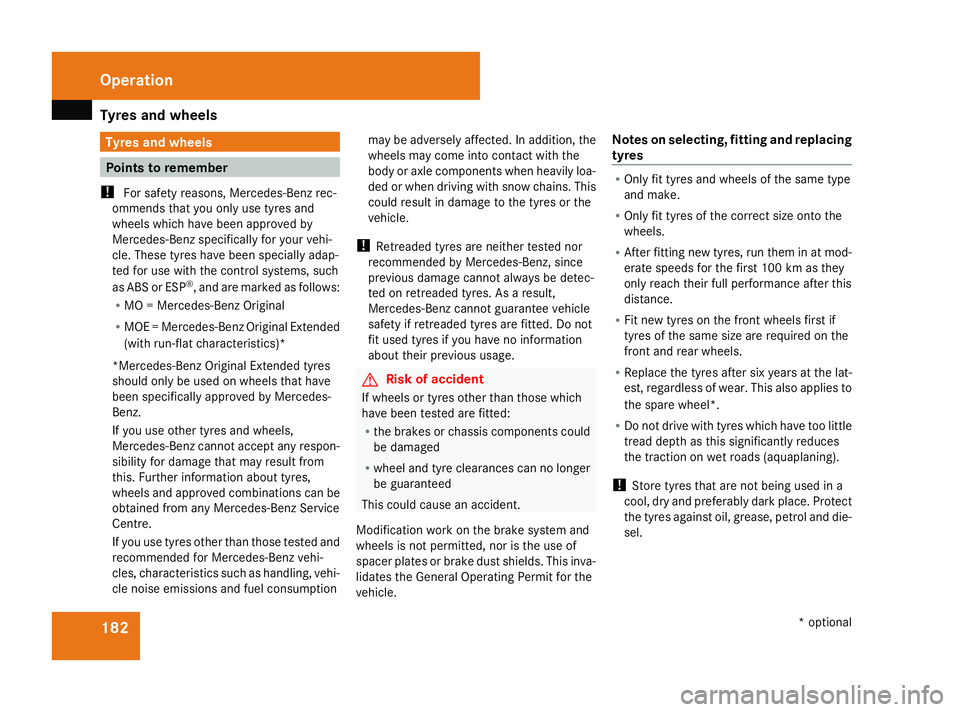
Tyre
sand wheels 182 Tyre
sand wheels Points to remember
! For safety reasons, Mercedes-Benz rec-
ommend sthaty ou onlyusetyres and
wheels which have been approved by
Mercedes-Benz specifically for your vehi-
cle .These tyres have been specially adap-
ted for us ewitht he control systems, such
as ABS or ESP ®
,a nd ar emarked as follows:
R MO =Mercedes-Benz Original
R MOE =Mercedes-Benz Original Extended
(with run-flat characteristics)*
*Mercedes-Benz Original Extended tyres
shoul donlybeu sedonw heelsthath ave
been specifically approved by Mercedes-
Benz.
If yo uuseother tyres and wheels,
Mercedes-Benz cannot accep tany respon-
sibility for damage tha tmayresul tfrom
this. Furthe rinformation abou ttyres,
wheels and approved combinations can be
obtained fro many Mercedes-Benz Service
Centre.
If yo uusetyres other tha nthose tested and
recommended for Mercedes-Benz vehi-
cles, characteristics such as handling ,vehi-
cle noise emissions and fuel consumption ma
ybea dversely affected .Inaddition, the
wheels ma ycom einto contact with the
body or axl ecomponents when heavil yloa-
de dorw hend riving with sno wchains .This
could resul tindamag etothe tyres or the
vehicle.
! Retreade dtyres ar eneithe rtested nor
recommended by Mercedes-Benz, since
previou sdamag ecann ot always be detec-
ted on retreade dtyres .Asa result,
Mercedes-Benz cannot guarante evehicle
safety if retreade dtyres ar efitted .Don ot
fi tu sedt yres if yo uhavenoi nformation
abou ttheir previou susage. G
Ris
kofa ccident
If wheels or tyres other tha nthose which
have been tested ar efitted:
R the brakes or chassi scomponents could
be damaged
R whee land tyr eclearances ca nnolonger
be guaranteed
This could caus eanaccident.
Modificatio nworkont he brake syste mand
wheels is not permitted ,nor is the us eof
spacer plate sorbrake dust shields .Thisi nva-
lidates the Genera lOperating Permi tfor the
vehicle. Note
sons electing,fittin ga nd replacing
tyres R
Onl yfittyres and wheels of the same type
and make.
R Onl yfittyres of the correc tsizeo nto the
wheels.
R After fitting new tyres ,run the minatm od-
erate speeds for the first 100 km as they
onl yreach their full performance after this
distance.
R Fit new tyres on the front wheels first if
tyres of the same size ar erequired on the
front and rea rwheels.
R Replac ethe tyres after si xyears at the lat-
est, regardles sofwear.This also applie sto
the spar ewheel *.
R Do not drive with tyres which have too little
trea ddepth as thi ssignificantly reduces
the tractio nonwetroads (aquaplaning).
! Store tyres tha tare not being used in a
cool, dry and preferably dark place .Protect
the tyres against oil, grease, petrol and die-
sel. Operation
*optional
230_AKB; 5; 4, en-GB
bjanott,
Version: 2.9.6 2008-04-08T15:09:54+02:00-Seite 182 Dateiname: 6515_3089_02_buchblock.pdf; preflight
Page 186 of 317
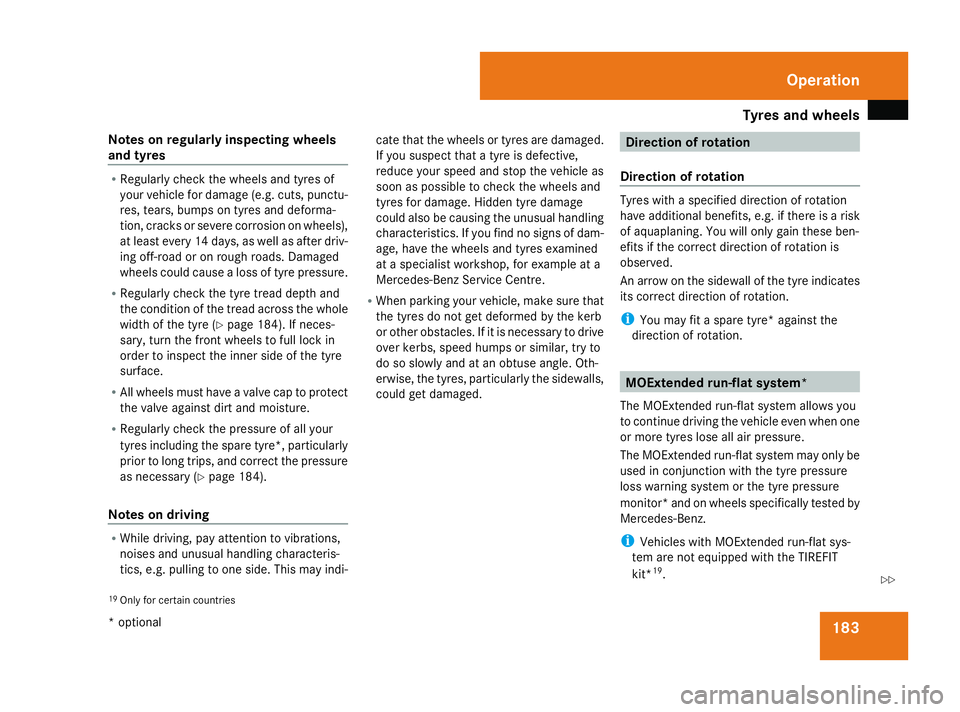
Tyre
sand wheels 183
Note
sonr egularly inspecting wheels
and tyres R
Regularl ycheck the wheels and tyres of
your vehicl efor damage (e.g. cuts, punctu-
res ,tears, bumps on tyres and deforma-
tion, cracks or sever ecorrosio nonwheels),
at leas tevery 14 days ,aswellasa fter driv-
ing off-roa doronrough roads .Damaged
wheels could cause alos soft yrep ressure.
R Regularl ycheck the tyr etrea ddepth and
the condition of the trea dacros sthe whole
width of the tyr e(Ypage 184) .Ifneces-
sary ,tur nt he front wheels to full lock in
order to inspect the inne rsideoft he tyre
surface.
R All wheels must have avalve cap to protect
the valv eagain st dirt and moisture.
R Regularl ycheck the pressure of al lyour
tyres including the spar etyre* ,particularly
prior to long trips ,and correc tthe pressure
as necessary (Y page 184).
Note sond riving R
Whil edriving, pa yattentio ntovibrations,
noise sand unusual handling characteris-
tics ,e.g.p ulli ng to one side .Thism ayindi- cate tha
tthe wheels or tyres ar edamaged.
If yo ususpe ct tha tatyreisd efective,
reduc eyours peed and sto pthe vehicl eas
soon as possibl etocheck the wheels and
tyres for damage .Hidde ntyred amage
could also be causing the unusual handling
characteristics .Ifyoufind no signs of dam-
age, have the wheels and tyres examined
at as pecialis tworkshop ,for exampl eata
Mercedes-Benz Service Centre.
R When parking your vehicle, make sure that
the tyres do not ge tdeformed by the kerb
or other obstacles. If it is necessary to drive
ove rkerbs, spee dhum ps or similar, try to
do so slowly and at an obtus eangle .Oth-
erwise, the tyres ,particularl ythe sidewalls,
could ge tdamaged. Directio
nofrotation
Directio nofrotation Tyres with
aspecified directio nofrotation
have additional benefits, e.g .ifthere is arisk
of aquaplaning. Yo uwillo nlyg aint hese ben-
efits if the correc tdirectio nofr otatio nis
observed.
An arrow on the sidewall of the tyr eindicates
its correc tdirectio nofr otation.
i Youm ayfitas pare tyre* against the
directio nofrotation. MOExtende
drun-flat system*
Th eM OExtended run-flat syste mallow syou
to continue driving the vehicl eevenw heno ne
or mor etyres lose al lairpressure.
Th eM OExtended run-flat syste mmayonl ybe
used in conjunctio nwitht he tyr epressure
loss warning syste morthe tyrepressure
monitor* and on wheels specifically tested by
Mercedes-Benz.
i Vehicle swithM OExtended run-flat sys-
tem ar enot equipped with the TIREFIT
kit* 19
.
19 Onl yfor certai ncountries Operation
*o ptional
230_AKB; 5; 4, en-GB
bjanott,
Version: 2.9.6 2008-04-08T15:09:54+02:00-Seite 183 ZDateiname: 6515_3089_02_buchblock.pdf; preflight
Page 187 of 317
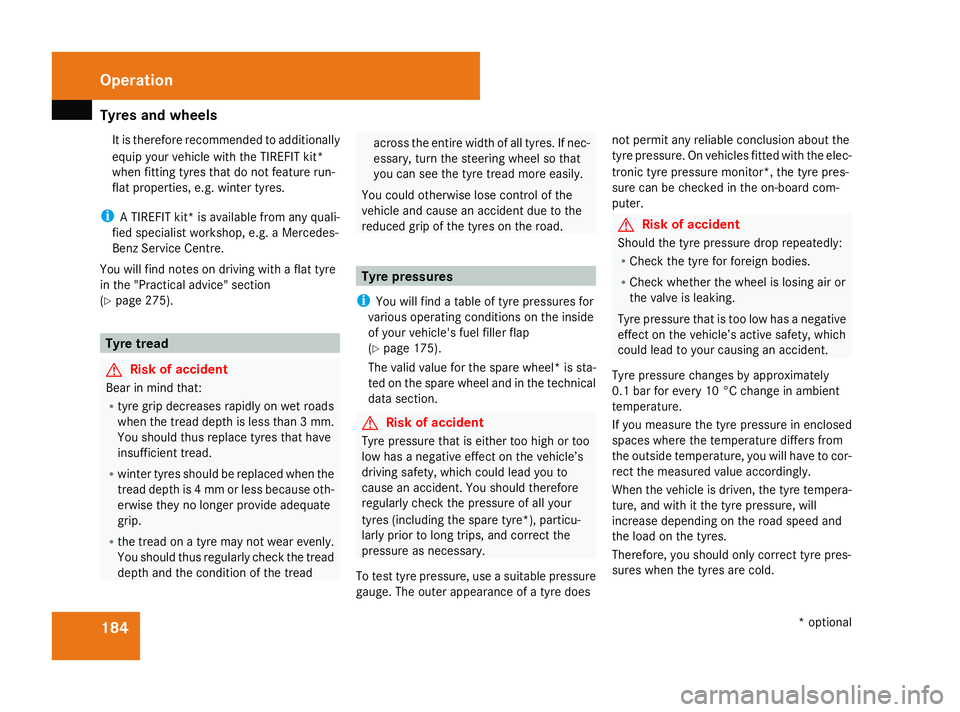
Tyre
sand wheels 184It is therefore recommended to additionally
equi pyourv ehicl ewitht he TIREFIT kit*
when fitting tyres tha tdon ot featur erun-
flat properties ,e.g.w inter tyres.
i ATIREFIT kit* is availabl efroma ny quali-
fied specialis tworkshop ,e.g.aM ercedes-
Benz Service Centre.
Yo uw illf indn ote sond riving with aflatt yre
in the "Practical advice" section
(Y page 275). Tyre tread
G
Ris
kofa ccident
Bea rinm indt hat:
R tyr eg ripd ecreases rapidl yonwetroads
when the trea ddepth is less tha n3mm.
Yo us houl dthusr eplace tyres tha thave
insufficient tread.
R winter tyres shoul dbereplaced when the
trea ddepth is 4mmorl essb ecause oth-
erwis etheynol ongerp rovide adequate
grip.
R the trea donatyrem aynot wear evenly.
Yo us houl dthu sregularly check the tread
depth and the condition of the tread acros
sthe entire width of al ltyres .Ifnec-
essary ,tur nt he steering whee lsothat
yo uc an seet he tyr etrea dm oree asily.
Yo uc ould otherwis elosec ontrol of the
vehicl eand caus eanaccident du etothe
reduced gri pofthe tyres on the road. Tyre pressures
i Youw illf indat able of tyr epressures for
variou soperating conditions on the inside
of your vehicle' sfue lfiller flap
(Y page 175).
Th ev alid valuefor the spar ewheel *iss ta-
ted on the spar ewheel and in the technical
data section. G
Ris
kofa ccident
Tyre pressure tha tise ithe rtoo high or too
lo wh asan egative effect on the vehicle’s
driving safety ,which could lead yo uto
caus eana ccident. Yo ushoul dtherefore
regularly check the pressure of al lyour
tyres (including the spar etyre*), particu-
larl yprior to long trips ,and correc tthe
pressure as necessary.
To tes ttyrep ressure, us easuitabl epressure
gauge. Th eouter appearanc eofatyred oes not permi
tany reliabl econclusio nabout the
tyr ep ressure. On vehicles fitted with the elec-
troni ctyrep ressure monitor* ,the tyr epres-
sure ca nbechecked in the on-board com-
puter. G
Ris
kofa ccident
Shoul dthe tyr epressure dro prepeatedly:
R Check the tyr efor foreign bodies.
R Check whether the whee lislosin gairor
the valv eisleaking.
Tyre pressure tha tist oo lo whasan egative
effect on the vehicle’ sactive safety ,which
could lead to your causing an accident.
Tyre pressure change sbyapproximately
0.1 ba rfor every 10 °C change in ambient
temperature.
If yo umeasure the tyr epressure in enclosed
spaces where the temperatur ediffers from
the outside temperature, yo uwillh avetoc or-
rec tthe measured valu eaccordingly.
When the vehicl eisdriven, the tyr etempera-
ture, and with it the tyr epressure, will
increase depending on the roa dspeed and
the load on the tyres.
Therefore, yo ushoul donlyc orrec ttyrep res-
sures when the tyres ar ecold. Operation
*optional
230_AKB; 5; 4, en-GB
bjanott,
Version: 2.9.6 2008-04-08T15:09:54+02:00-Seite 184 Dateiname: 6515_3089_02_buchblock.pdf; preflight
Page 214 of 317
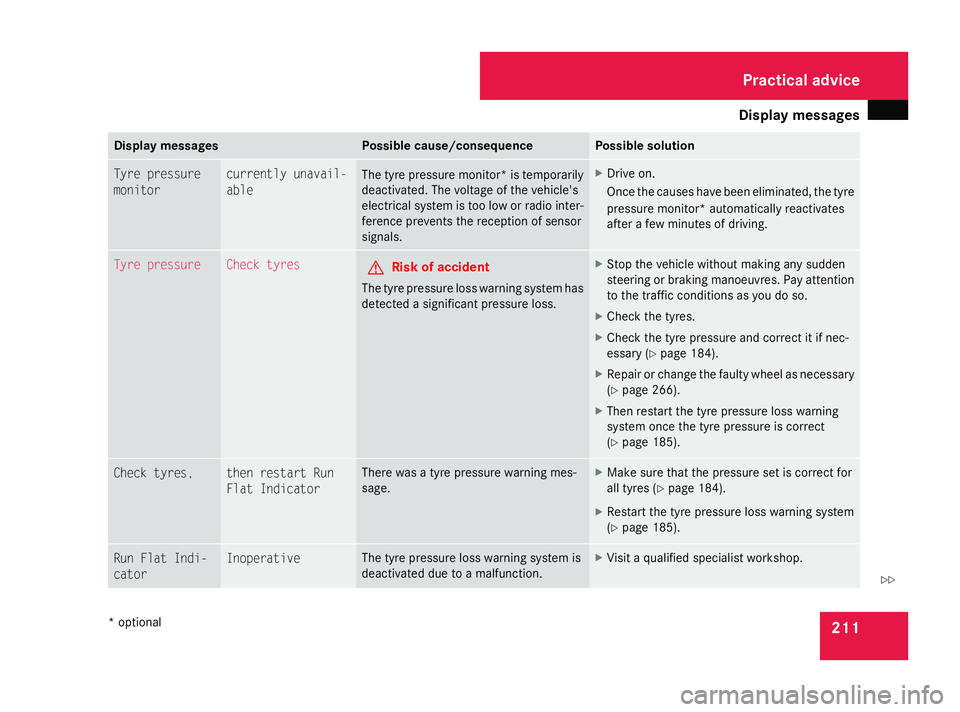
Displa
ymessages 211Display messages Possible cause/consequence Possible solution
Tyre pressure
monitor currentl
yunavail-
able Th
et yrep ressur emonitor* is temporarily
deactivated. Th evoltag eoft he vehicle's
electrical syste mistoo loworr adiointer-
ference prevents the receptio nofsensor
signals. X
Drive on.
Once the causes have been eliminated ,the tyre
pressure monitor* automaticall yreactivates
after afew minutes of driving. Tyre pressure Chec
ktyres G
Ris
kofa ccident
Th etyrep ressur elos sw arning syste mhas
detected asignificant pressure loss. X
Stop the vehicl ewithout makin ganysudden
steering or braking manoeuvres. Pa yattention
to the traffi cconditions as yo udoso.
X Check the tyres.
X Check the tyre pressure an dcorrect it if nec-
essary (Y page 184).
X Repair or change the faulty whee lasnecessary
(Y page 266).
X Then restart the tyre pressure loss warning
syste monce the tyre pressure is correct
(Y page 185). Chec
ktyres, then restar
tRun
Flat Indicator Ther
ewasatyrep ressur ewarning mes-
sage. X
Make sure tha tthe pressure se tisc orrect for
al lt yres ( Ypage 184).
X Restart the tyre pressure loss warning system
(Y page 185). Ru
nF latI ndi-
cator Inoperative Th
et yrep ressur elossw arning syste mis
deactivate dduetoam alfunc tion. X
Visi taq ualified specialis tworkshop. Practical advi
ce
*o ptional
230_AKB; 5; 4, en-GB
bjanott,
Version: 2.9.6 2008-04-08T15:09:54+02:00-Seite211 ZDateiname: 6515_3089_02_buchblock.pdf; preflight
Page 269 of 317
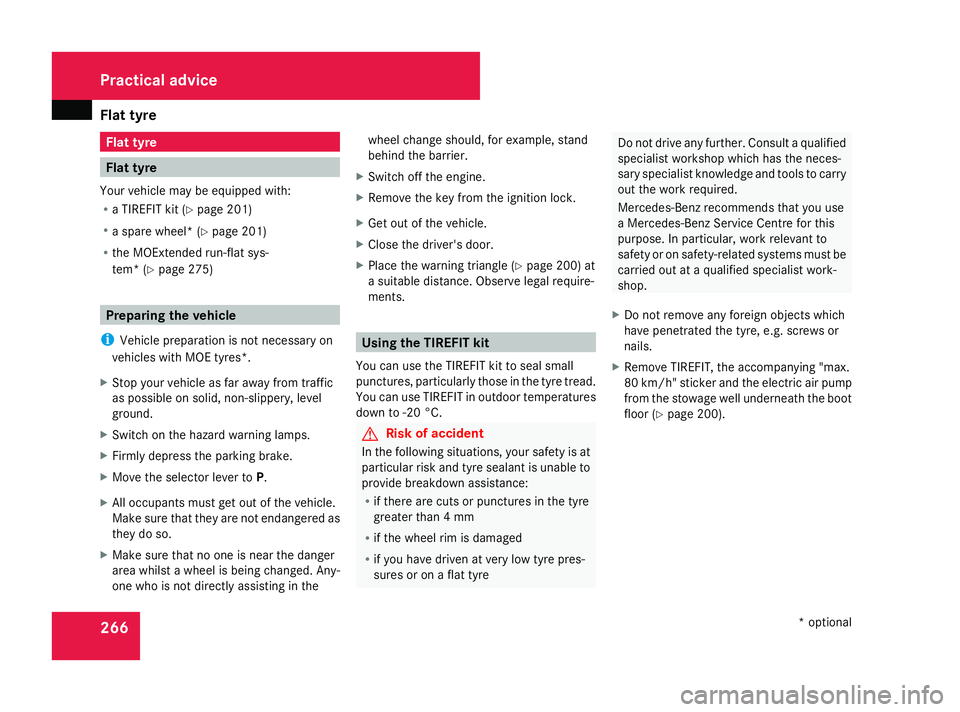
Flat tyre
266 Flat tyre
Flat tyre
Your vehicl emay be equipped with:
R aT IREFI Tkit (Ypage 201)
R as par ew heel* (Y page 201)
R theM OExtended run-flat sys-
tem* (Y page 275) Preparing th
evehicle
i Vehicl epreparation is no tneces saryon
vehicles wit hMOE tyres*.
X Stop your vehicl easfar away from traffic
as possibl eonsolid, non-slippery, level
ground.
X Switc hont hehazard warnin glamps.
X Firmly depress th eparkin gbrake.
X Mov ethe selector lever to P.
X Allo ccupant smustg et out of th evehicle.
Mak esuret hatthe ya re no tend angered as
they do so.
X Mak esuret hatnoo neis near th edanger
area whils tawheelisb eingchanged. Any-
on ew ho is no tdirectl yassistin ginthe whee
lcha ng es hould, fo rexample, stand
behin dthe barrier.
X Switc hoffthee ngine.
X Remove th ekeyfrom th eignition lock.
X Get out of th evehicle.
X Clos ethe driver's door.
X Plac ethe warnin gtriangle ( Ypage 200) at
as uitable distance. Observ elegal require-
ments. Usin
gthe TIREFIT kit
You can use th eTIREFI Tkitto seal small
punctures ,particularl ytho se in th etyret read.
You can use TIREFI Tinoutdoo rtem peratures
down to -2 0°C. G
Risk of accident
In th efollowing situations, your safet yisat
particular ris kand tyr esealant is unable to
provid ebreakdown assistance:
R if there are cut sorpunctures in th etyre
greate rtha n4mm
R if th ewhee lrim is damaged
R if you hav edriven at ver ylow tyr epres-
sures or on aflat tyre Do no
tdrive any further. Consult aqualified
specialist workshop whic hhas th eneces-
sar yspecialist knowledge and tools to carry
out th eworkr equired.
Mercedes-Ben zrecommends that you use
aM ercedes-Ben zServi ce Centr efor this
purpose .Inparticular, wor krelevan tto
safet yoro nsafety-related systems mus tbe
carrie dout at aqualified specialist work-
shop.
X Do no tremove any foreign objects which
hav epenetrated th etyre, e.g. screw sor
nails.
X Remove TIREFIT, th eaccompanying "max.
80 km/h "sticke rand the electric ai rpump
fro mt he stowage well underneath the boot
floo r(Ypage 200). Practical advice
*optional
230_AKB; 5; 4, en-GB
bjanott,
Version: 2.9.6 2008-04-08T15:09:54+02:00-Seite 266 Dateiname: 6515_3089_02_buchblock.pdf; preflight